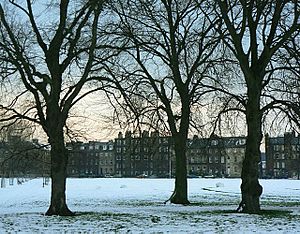Articles of Leith facts for kids

The Articles of Leith were a peace agreement made between the Protestant group known as the Lords of the Congregation and Mary of Guise, who was the ruler of Scotland at the time. This agreement was signed on July 25, 1559. It was an important step in a big conflict that later led to the Scottish Reformation, which changed Scotland's religion.
Even though the agreement made the Protestant forces leave Edinburgh for a short time, disagreements about what the treaty actually meant and whether it was followed correctly caused more problems in Scotland.
Why was there a crisis?
After some religious riots started in Perth, the Protestant Lords decided to fight against Mary of Guise and the French soldiers who supported her rule in Scotland. In June 1559, the Lords took control of Edinburgh. They even took over Holyrood Palace and seized the equipment used to make coins from the Scottish Mint.
News arrived that the King of France, Henry II of France, had died. This made John Knox, a Protestant leader, hopeful that France would stop sending help. However, a Catholic army started moving towards Edinburgh from Dunbar. Also, the leader of Edinburgh Castle, Lord Erskine, decided to support Mary of Guise.
The French soldiers then moved into Leith, a town near Edinburgh. Leith surrendered without a fight, partly because Robert Logan of Restalrig convinced them to. The Protestant Lords gathered their forces at Craigengalt. Because of these difficult circumstances, they had to agree to a truce and leave Edinburgh, rather than fight a battle they knew they couldn't win. The terms of this truce were written down at Leith Links on July 24, 1559.
The next day, on July 25, 1559, some of the Protestant leaders, including the Earl of Argyll, the Earl of Glencairn, and Lord James, met with Mary of Guise's supporters. These included the Duke of Châtellerault and the Earl of Huntly. They met at a place called 'Quarrel Holes' between Edinburgh and Leith. The Duke and the Earl promised to stop supporting Mary of Guise if she broke any part of the agreement.
The Protestant Lords signed the Articles of Leith on July 25, 1559. The agreement included important promises about their religion. Henri Cleutin, the Earl of Huntly, and the Duke of Châtellerault signed for Mary of Guise. William Kirkcaldy of Grange sent news of this agreement to James Croft in Berwick-upon-Tweed.
What did the Articles say?
A copy of the Articles, written in French, shows what was agreed with Mary of Guise on July 23, 1559. She promised that the Scottish Parliament would review religious matters and church property on January 10, 1560.
Here's a simple summary of the main points:
- The Protestant Lords agreed to leave Edinburgh as Mary of Guise wished.
- The Lords would give back the coin-making equipment they took from the mint. They would also return Holyrood Palace to its keeper.
- The Lords promised to obey Mary, Queen of Scots, her husband Francis II of France, and Mary of Guise, as well as the law. The only exception was on matters of religion.
- The Lords agreed not to bother church leaders or take their property.
- The Lords would not use force against churches or monasteries.
- The people of Edinburgh could choose their own religion and follow their conscience until January 10.
- Mary of Guise promised not to bother Protestant preachers or take their belongings. Everyone should be able to live privately according to their beliefs.
What happened next?
Even though the Lords of the Congregation left Edinburgh and went to Stirling after the 'Leith Agreement,' it didn't lead to a peaceful time. Instead, more French soldiers arrived to support Mary of Guise. The Lords said this broke an article of the Leith agreement that said no soldiers should be stationed in Edinburgh. However, French copies of the agreement don't actually have this specific rule.
By August 28, 1559, Mary of Guise publicly announced that she had not broken the truce. She said that rumors about her breaking the agreement were spread by the Protestant Lords. Regarding the sixth article, which allowed Edinburgh to choose its religion, the Duke, Huntly, and the leader of Edinburgh, Lord Seton, couldn't convince the town to allow the Catholic Mass to be held in St Giles.
The Protestant group kept gaining more support. The Duke of Châtellerault even switched sides after his son, the Earl of Arran, was secretly brought home from France by English agents. When the Leith agreement was made, Sir James Croft had told Scottish agents that Elizabeth I of England couldn't deal with a "confused multitude." He said that Arran's presence was needed to create a stronger group. With the Duke, a former ruler, as their leader, the Protestant Lords were able to get military help from England through the Treaty of Berwick.
After Mary of Guise died and the Siege of Leith ended, Scotland officially became a Protestant country, even though its queen, Mary, was Catholic.

